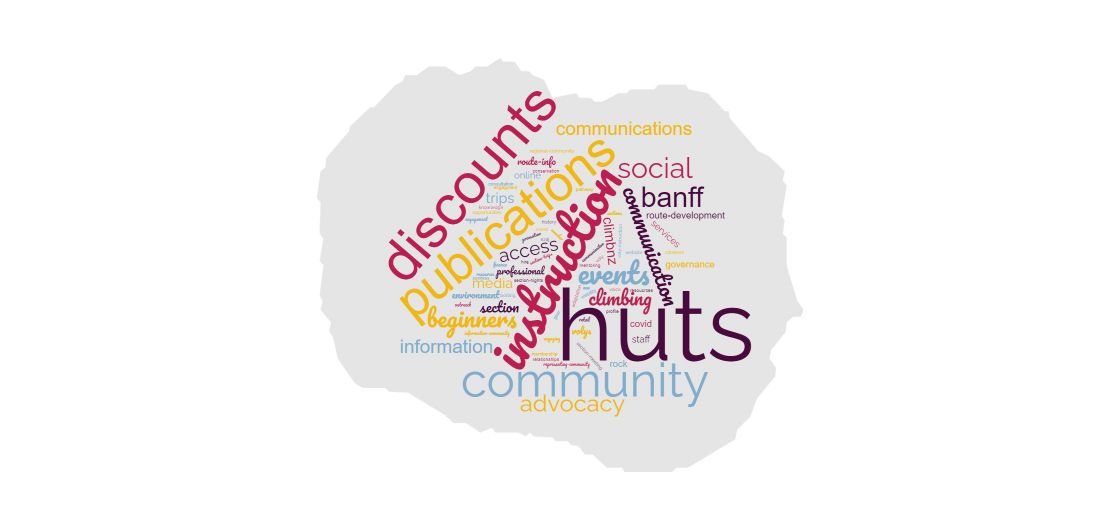
NZAC Annual Membership Survey 2022 Results
Executive summary
This analysis of the NZAC Membership survey 2022 contains both quantitative and qualitative data collected using SurveyMonkey in April 2022. It has been analysed and compared to the 2019 NZAC membership survey.
The data shows that our members undertake a diverse range of climbing and snow sports. They are generally satisfied with the range of services offered and use many of these services, as it suits them. Compared to previous years, the perceived value and overall performance has dropped a little.
The comments data backed up the quantitative data, in that most respondents commented positively about the huts, publications and instruction courses—our core services. The suggestions for improvements were vast, but there was strong feedback for the need for more trips and increased capacity and scope of instruction courses. There was also a theme for supporting youth and beginners better, and ensuring that we provide a continuous pathway for members to advance their climbing.
Suggestions for further work include improving the number of trips and courses available by working with the Section council. Supporting and encouraging youth and strengthening the pathway for climbers is work already contained within the annual plan 2022/23.
Introduction
The survey was undertaken from 8-22 April 2022. It was advertised through the national newsletter and on social media and open to members and non-members. There were 315 responses collected by SurveyMonkey. Non-members could only answer questions one and two—what involvement they have in climbing and their membership status.
The survey was incentivised with a random spot prize of a $150 Macpac voucher, which was randomly drawn after the closing date.
1.0 Summary results
Current climbing and club involvement

Most participants identified as active climbers (68%) with 9% stating they are not a climber. Around 10% said they had never been a member and 7% were past members. These participants were excluded from this point on. 20% of responses came from members of more than 10 years.
Joining NZAC
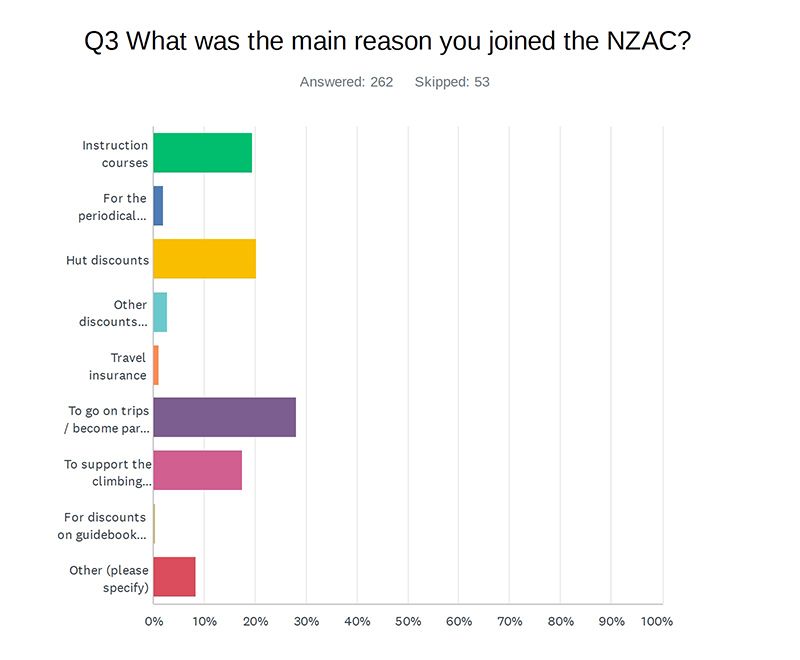
The main reason for joining was varied, but 28% said it was to go on trips / become part of the NZAC community. Other popular answers were hut discounts (20%), instruction courses (19%) and to support the climbing community (18%).
Participation
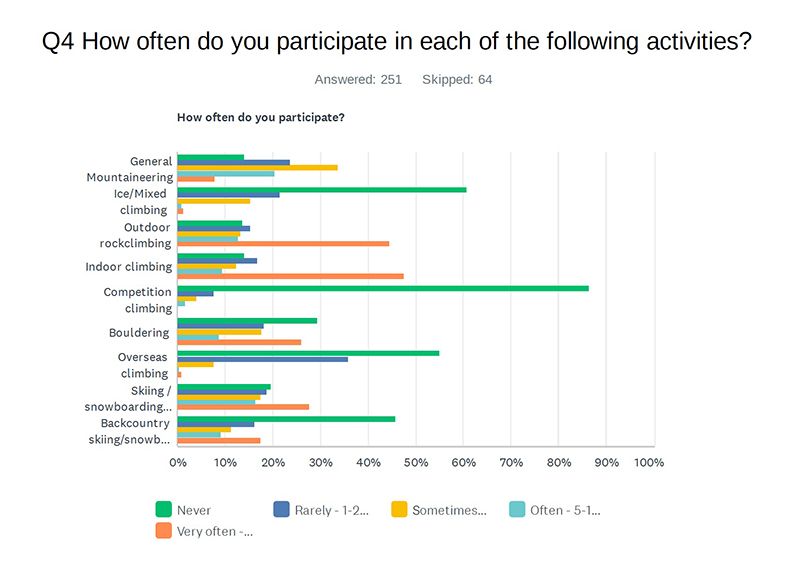
Mountaineering, outdoor and indoor rock climbing had 86% each of participants indicating that they had undertaken the activity at least once in the last two years. The frequency of outdoor and indoor climbing far outweighed any other activity, unsurprisingly. Snowsports (within a ski field) were undertaken at least once by 80% of respondents and bouldering by 72% of respondents.
Services offered
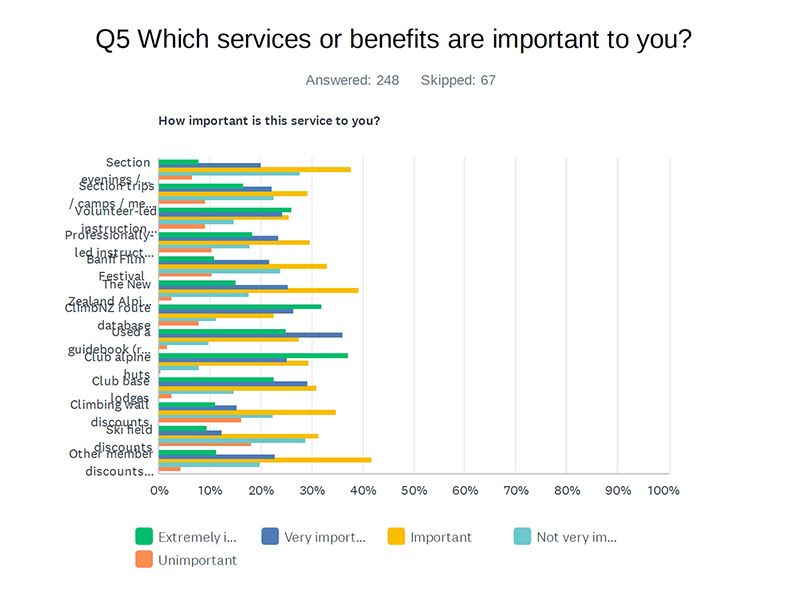
Alpine huts topped the most important services again, with 37% of respondents saying this was extremely important and 62% saying it was extremely important or very important. Other important services were ClimbNZ, guidebooks, and volunteer-led instruction and base lodges. It depends on whether you focus on only ‘extremely important’ or both ‘extremely important' and ‘important’ as to where they rank specifically.
The lowest ranking on importance were the climbing wall and ski specific discounts. Neither of these had particularly high ratings of ‘unimportant’, suggesting that they are probably not completely irrelevant, more just a nice to have rather than a core service.
Services used

The publications (NZAJ, guidebooks and ClimbNZ) were the most frequently used services. This is unsurprising given their accessibility and also the year of disruptions and restricted movement that has occurred.
Professionally led instruction was least utilised, but this isn’t surprising as there are a very restricted number of spots available and these are typically sold out.
Value for money
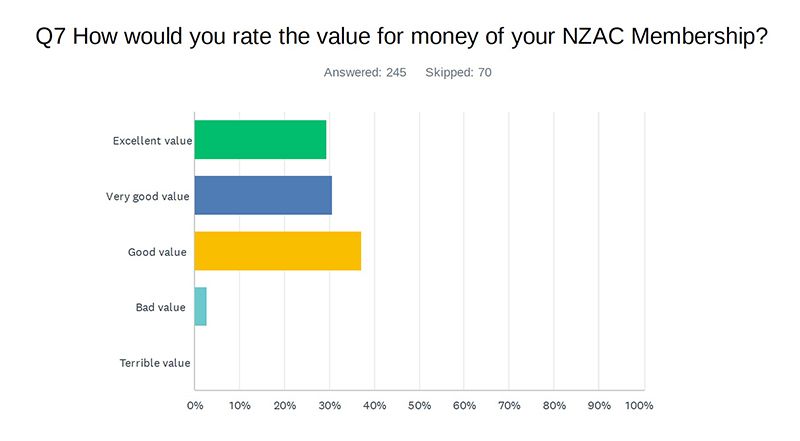
29% rated it excellent, 30% very good and 37% good value for money. This is a little below ratings from 2019 (30%, 32% and 35% respectively).
Overall performance of NZAC
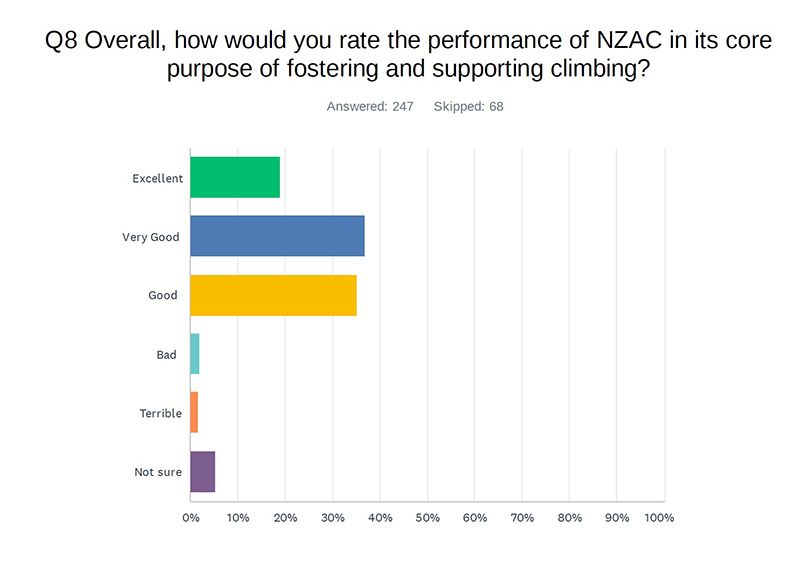
The overall performance of the NZAC was rated as excellent by 19% or respondents, very good by 37% of respondents and good by 35% of respondents. 4% rated the performance as bad or terrible. In 2019 the numbers were 29% (excellent), 41% (very good) 22% (good) and 3% bad or terrible.
There is a drop in satisfaction of the performance of the NZAC from 2019.There is also a slight drop in the value for money. Possible causes of this are discussed in part 3.
Demographics of respondents
The demographics of the respondents generally mirror our membership in terms of age, gender and location.
2.0 Comments analysis
The comments data provides rich information. In order to try and understand the comments, we've created word clouds for each question. The more frequently a word comes up, the larger it appears in the word cloud. It provides a sense of the frequency of words in the comments. Two word clouds were created for each question: one from the raw comment data and one from data that was summarised into themes. The second relies on human interpretation and therefore is subject to bias. However, in the raw data respondents can use synonyms for the same theme, perhaps diluting a theme.
What are NZAC doing well?
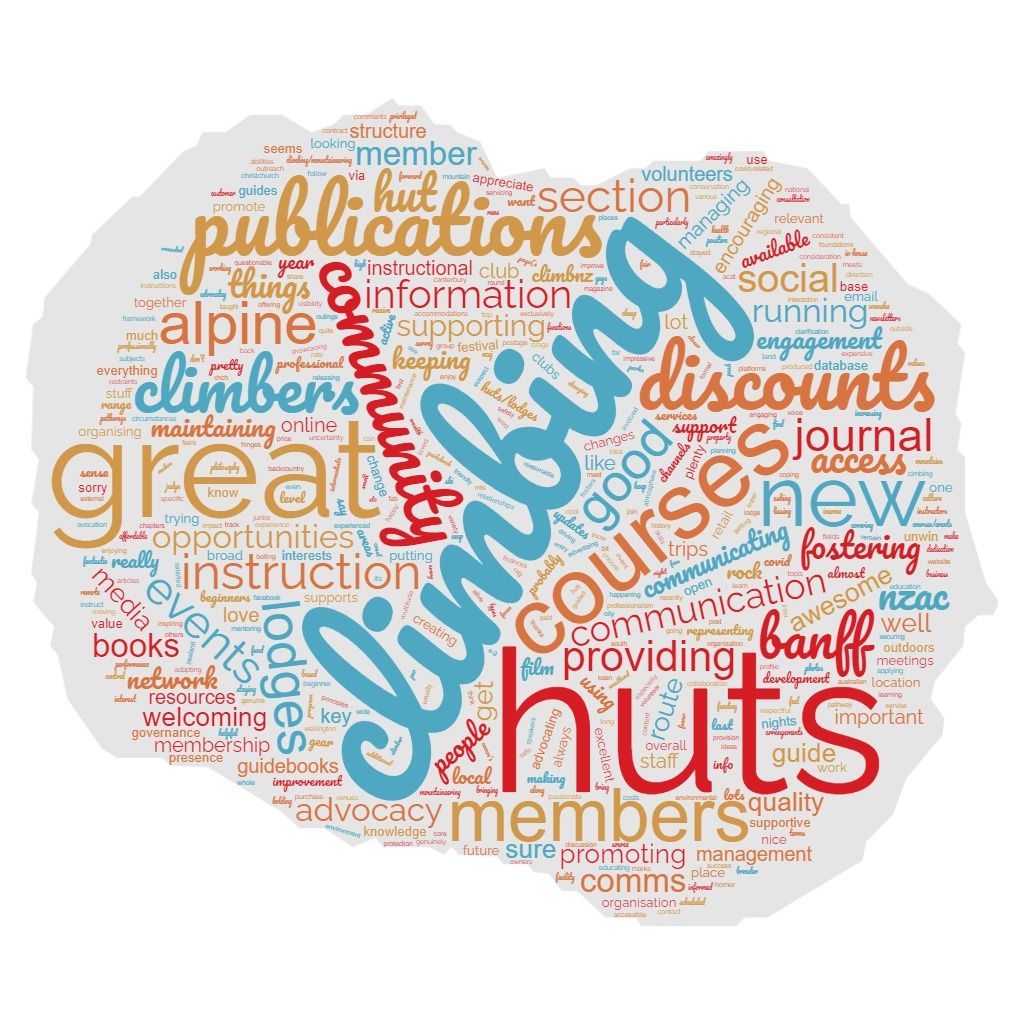
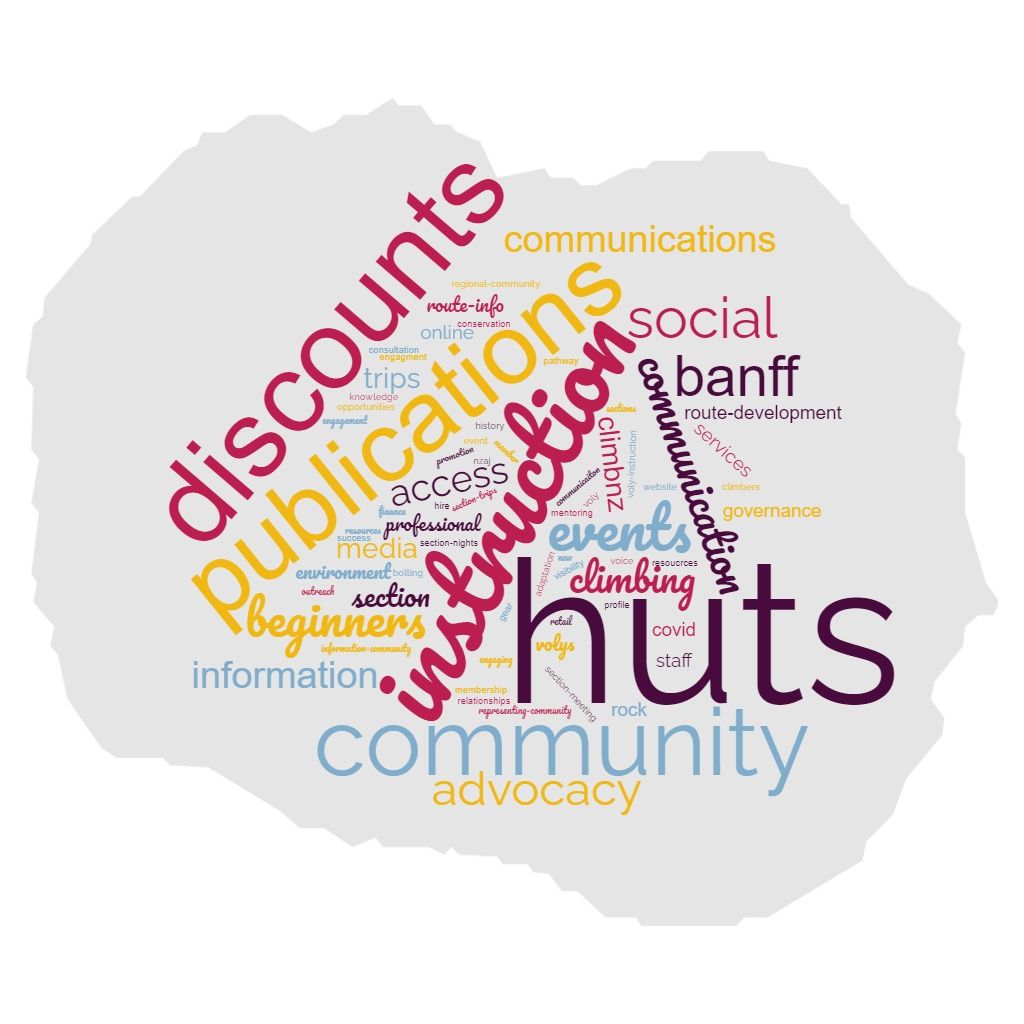
What do NZAC need to improve?
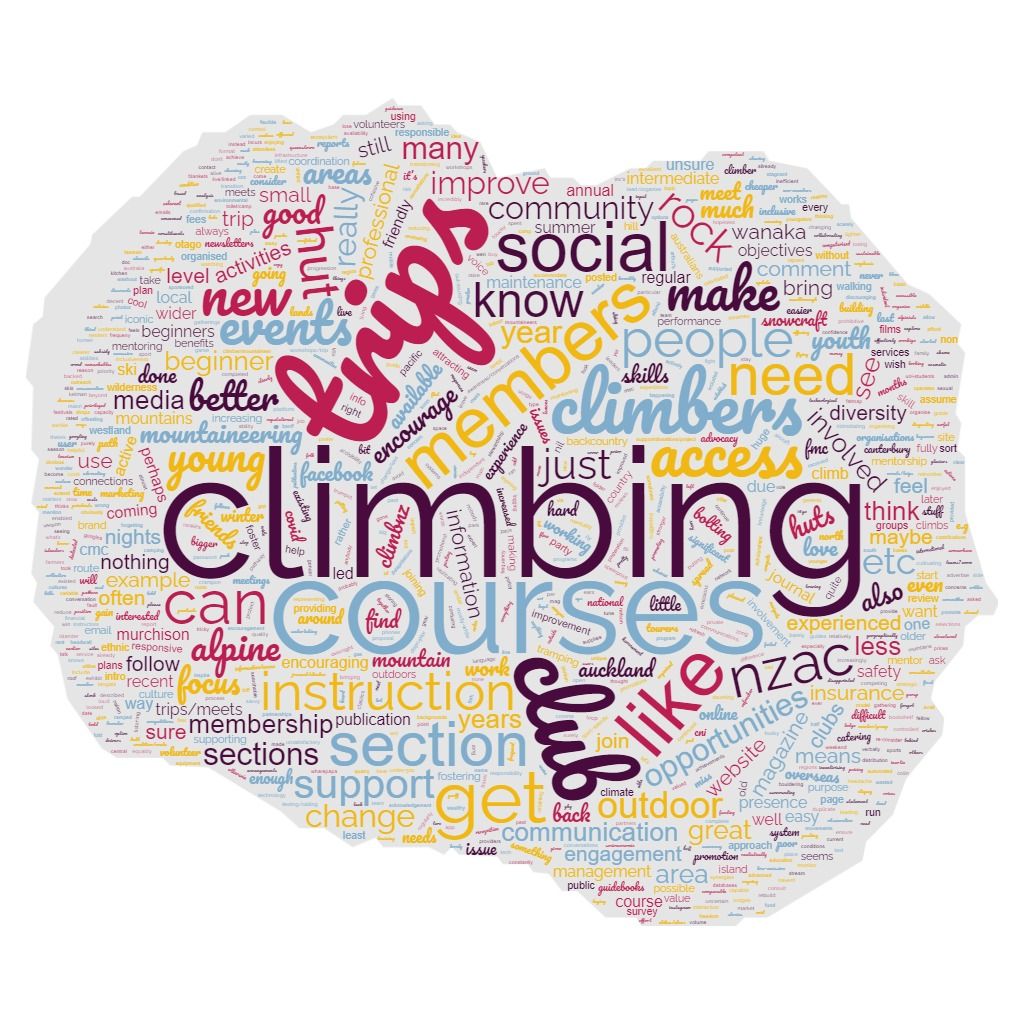
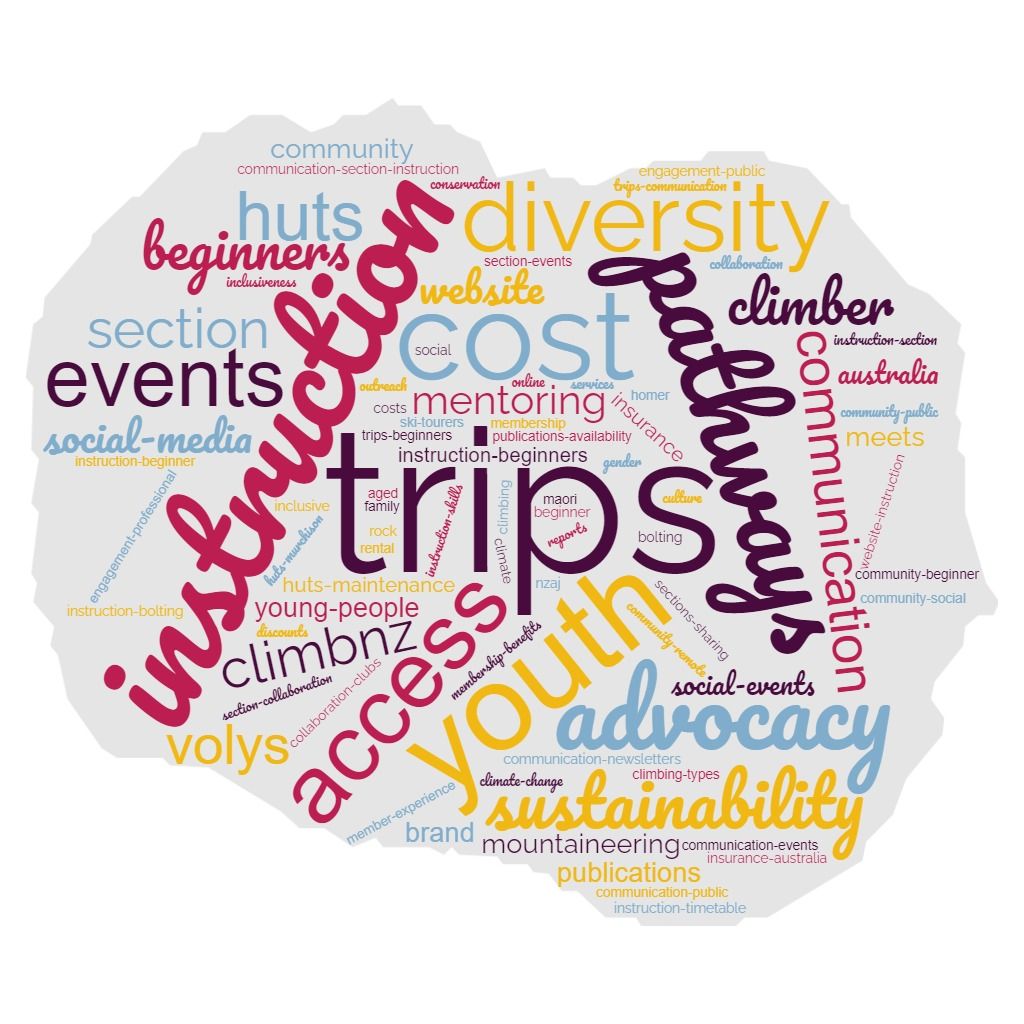
3.0 Discussion
Summary of results
It is worth noting that the Club is a diverse group, with interests, opinions and priorities that often differ widely. It is a balancing act to try and accommodate all the interests of all of the members. There was an instance this year (as there is every year) where one comment said we didn’t have enough rock-climbing coverage and then the next said there wasn’t enough mountaineering coverage. However, we are looking for larger general trends in this discussion, while remembering the diversity of the Club.
The responses for the summary results around participation, services offered and services used have not changed vastly from previous years. There is still a broad mix of members doing an array of climbing and snow activities. In general, they think the services offered are relevant and appropriate for their needs.
There is a drop in the perceived value of membership and the overall performance of the Club. It is difficult to know what is driving this, although some will be answered in the analysis of the comments.
What are we doing well?
Generally speaking, the comments speak favourably of our services offered in huts, publications and instruction. This is generally reflective of the numerical results in part one. Respondents also think we are doing a good job with our communications and reasonably well at fostering community.
There are a number of themes that appear in both the positive and negative comments. The most common is access and advocacy, with approximately equal numbers of people saying we are doing a good and bad job at this. There also seems to be a lack of understanding about our relationship with ACAT, an expectation that we do more in this space ourselves, or a lack of communication of the ongoing work that NZAC completes in this area. In reality, it is probably a combination of all three.
What do we need to improve?
The clear themes for areas of improvement are around trips, availability of instruction, youth, and pathways for continued learning.
For trips, it is clear that respondents want more trips. They also want the trip paperwork simplified. More instruction courses both in availability and scope were requested. Price was also a consideration for the courses. Together, these themes appeared in approximately 30% of all comments (excluding ‘nothing’ and ‘unsure’).
More support for youth, both in attracting them to the Club, providing instruction, trips and then pathways for progression was a popular comment. There were also comments about ensuring that we have pathways for people to progress along including the trips to help them gain the necessary experience to advance. This also extended to supporting beginners especially with course and trip availability. To some extent these themes are interrelated.
There were some comments around huts, mostly related to expanding the network or improving on maintenance in some areas. Some refer to huts that do not belong to NZAC.
Lesser themes
There were some comments around continuing to build community through social interaction and events. Some of the comments acknowledge that this has been difficult through the last few years with Covid. Some respondents would like more social events spread across a more diverse geographic area.
There were some comments about climate change impacts, environmental stewardship and sustainability. There were also some around insurance, communications, diversity, Australian membership and cost of membership.
Other factors to consider
The last 2 years have been severely impacted by Covid. With some of the responses it is difficult to know whether once we fully return to pre-Covid levels the respondents will be satisfied. It is possible that the change to the publications regime, coupled with the reduction in events over the last two years, is part of what is influencing the perceived reduction in value. However, this is not strongly supported by the evidence from the comments.
There are external factors present now that may also be influencing the value. Cost of living is increasing quickly and will be worrying to many. It will cause many to examine their discretionary spending. People may be looking for more value from this discretionary spending and this too may be influencing opinions.
In the long-run, it is more important how we respond to these findings.
The way forward
The 2022/23 annual plan has been developed to have some flexibility for change and growth through the year. There are priority projects to be completed (Aspiring Hut refurbishment and ClimbNZ upgrade). Other National Office directed work will need to fall within the ‘Running the Club’ and ‘Membership’ projects.
The one area that clearly needs attention which the Board has agreed to add to the Annual Plan is the lack of trips and increasing instruction capacity. Both of these tasks currently rely heavily on Sections. The workplan for these areas will be created in conjunction with the Section Council.
Youth, pathways and encouraging beginners is explicitly covered in the 2022/23 workplan. Although it will also rely on the Sections there are plenty of opportunities that we can advance in parallel to this work.
A summary of the 2022/23 Annual Plan and Budget will be available in the next few weeks.
